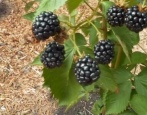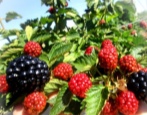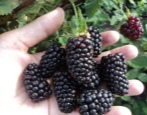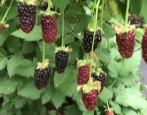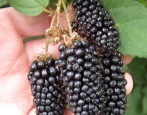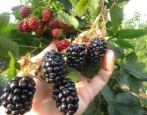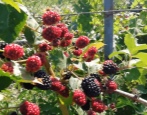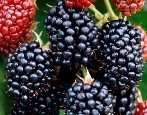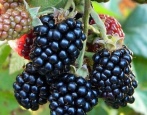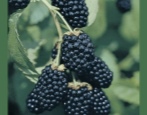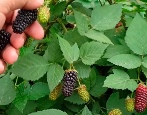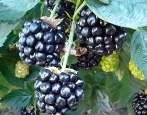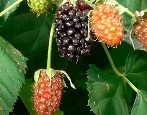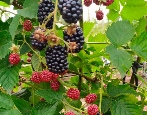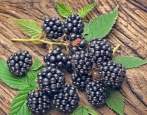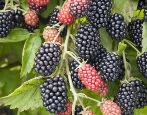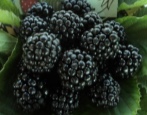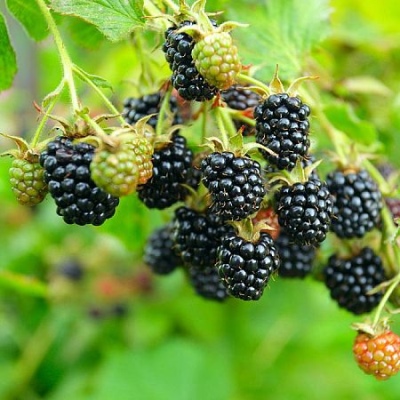
- Authors: Dr. Scott
- Taste: sweet
- Scent : pronounced
- The presence of thorns: No
- Berry weight, g: 5-8
- Berry size: medium
- Berry color: black
- Fruiting period: end of July and before frost
- Yield: 10-25 kg per bush
- Frost resistance, ° C / Winter hardiness: low
Blackberry is considered one of the most common berry bushes. The presence of more than 4 hundred varieties of this plant indicates its high popularity. The berries of this shrub are not often found on the market, but they have an extraordinary taste. Black Satin is one of the most common varieties today. It is found in many areas, but so far it is rarely planted for commercial purposes.
Description of the variety
The bush grows very well and quickly, practically no protective thorns are formed, which greatly simplifies the harvesting process. Often a support is created close after planting, since the height reaches 7 meters, and strong winds can harm the plant.
Until reaching a height of 1.5 meters, growth occurs exclusively in the vertical direction. After the plant begins to grow and creep a little along the ground.
The bushes of the considered variety are characterized by high vigor of growth, each year they grow with greater vigor in the absence of diseases. Many summer residents fell in love with it because of its low tendency to overgrowth formation.
Ripening terms
Black Satin bears fruit for a long period, which depends on the climate in the region. In a southern climate, the first berries ripen at the end of July, the harvest period stretches until the end of September.
The berries ripen at intervals of 2-3 days. At the same time, a tight separation is observed, which excludes shedding at maturity.
Yield
The popularity among summer residents is primarily associated with high yields. If you follow all the recommendations for care, about 20 kg of harvest is obtained from a bush that is 3-4 years old.
With a long ripening period, fresh berries can be counted on within a few weeks. They remain large and do not lose their flavor.
Berries and their taste
The shape is rounded, but more like a cone, the weight is usually 6 grams. Closer to the top of the bush, larger berries weighing 5-8 grams can form.
The fruits form small clusters, each containing 15 pieces. After full maturation, the surface acquires a black shade with a shine.
There are other features as well.
-
The taste is pleasant, with a slightly pronounced sourness.
-
Summer residents, according to their own observations, concluded that with good care and timely watering, the fruits become larger and sweeter.
-
The blackberry looks very attractive. Once fully ripe, a beautiful ebb tide attracts attention. When unripe, the shade is very light.
Growing features
Despite the fact that the plant can be called unpretentious to growing conditions, only with proper care can you count on a good harvest. And also the correct choice of the place of growth is important.
Site selection and soil preparation
When choosing a place, it should be borne in mind that the plant is quite large, grows quickly, and flowers and berries will attract various insects. The most suitable place should correspond to several points.
-
The plant loves light, there should be no shadow nearby.
-
Adequate amount of light speeds up the maturation process.
-
Clean sandy soils are not suitable for this type of planting.
-
Too much moisture will negatively affect the root system. And also waterlogging of the territory is not allowed.
It is best to plant in the spring in the southern regions, where early cold weather is not observed, and in the autumn. Before planting, the entire site is dug up, cleared of weeds.
Planting holes are placed at a distance of 3 meters, nutrients, mineral and organic fertilizers are preliminarily introduced. The ground should not be too cold or wet.
After completing the planting work, the seedling is actively watered. Next, a root circle is created, which is mulched with compost and peat.
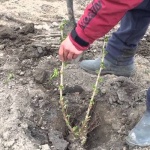

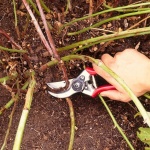
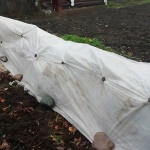
Diseases and pests
The plant infects several different diseases, if you do not respond to their appearance, the yield will decrease or even disappear.
The following are the most common problems.
Rust is spread by fungal spores when there is insufficient moisture. It appears as small brown dots that cover the stems and leaves. If you do not take control measures, the fungus covers the entire stem and turns into a dry film. The next year, the spores scatter, the entire stem dies off. At the first sign, an infusion of garlic is most effective.
Anthracnose is another fungal disease that appears already at high humidity. Purple spots can be observed on young shoots, then they become ulcers with rotting. Over time, the whole plant deforms, and the berries die off. There are no effective methods of combating the disease, the bush is destroyed along with the root, and only vegetables can be grown in its place.
The main thing is to timely inspect the bush for the appearance of diseases. At the initial stage of development, treatment will preserve the crop and the plant itself.
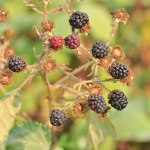
Reproduction
Black Satin gives long whips that you can drop in. Due to this, the rooting of new plants occurs.
Here are some expert recommendations.
-
Due to the strong lignification, there is a chance of breaking the whips. Therefore, it is recommended to use young green branches.
-
The recommended length of shoots is 30-35 cm. At the time of reproduction, grooves with a depth of about 20 cm are created, after placing the branch, it is slightly sprinkled with earth.
-
Under favorable growing conditions and the absence of disease, this method of reproduction allows you to get 3-4 new plants. A similar procedure is carried out at the end of July.
The method of propagation by green cuttings is also widespread. It is most suitable for the Black Satin variety. It is advisable to carry out the rooting process in early July.The upper third of the shoot turns out to be more tenacious, the last two buds are cut off.
After preparing the cuttings, they are planted in small cups. The soil for them is prepared with the calculation of a combination of equal parts of peat, sand and crushed expanded clay. Room humidity should be at least 95% at room temperature. It takes about one month to form the root system.
The variety in question is ideal for growing in a summer cottage. Its pleasant berry taste and other properties make it suitable for commercial breeding as well.



